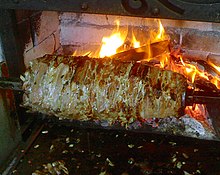Cağ kebabı (Turkish: [ˈdʒaː cebabɯ]) is a horizontally stacked marinated rotating lamb kebab variety, originating in Erzurum Province, Turkey.
 Cağ kebabı, from Erzurum. | |
| Course | Kebab |
|---|---|
| Place of origin | Ottoman Empire |
| Region or state | Erzurum |
| Created by | Disputed, with various lawsuits. Goes back to 18th century.[1] |
| Main ingredients | Marinated slices of lamb, tail fat, onion, sweet basil, black pepper and salt. |
This uniquely prepared kebab has become, as years passed, a trademark of Erzurum where all the famous Usta,[nb 1] like Şakir Aktaş and Kemâl Koç, run restaurants. Each claim to be descending from the exclusive inventors.
Cağ kebabı was registered and granted a geographical indication as 'Erzurum Oltu Cağ Kebabı' by the Turkish Patent and Trademark Office in 2010.[2][3][4]
Note that while it is increasingly available in most Turkish cities, the Cağ kebabı is especially popular in Erzurum, whereas enjoying an ever-growing success in Istanbul and Ankara.
History
editOttoman travel books of the eighteenth century cite a kebab cooked on wood fire consisting of a horizontal stack of meat, known as "Cağ Kebabı" in the Eastern Turkish province of Erzurum, which is probably the earlier form of döner as known.[citation needed]
Now, the kebab is very famous in Erzurum, Istanbul and many states in the EU.[5][6][7]
Etymology
editThe Turkish word cağ (IPA: [ˈdʒaː]) borrowed from Armeno-Georgian.[8][9] It means "spit" or skewer.[10] Hence the name of the kebab that consists of meat impaled on a huge spit.
Preparation
editSlices of lamb and large quantities of tail fat are left to marinate in a mixture of basil, black pepper, salt and sliced onions for the length of a day. They are then impaled on the spit (Cağ), and stacked thickly. The spit is then locked and transferred to the fire, where there is a fairly complicated device that controls the cooking of the spit. This typically includes a mechanism for turning the meat, another one for raising and lowering it, and also dents on the side to move the stack towards the fire as it gets thinner after servings are repeatedly cut away.
The meat used for Cağ kebabı is exclusively lamb.[11]
-
Stacking the lamb slices on the cağ
-
Cağ kebabı being cut
-
Newly impaled meat cooking on the cağ
-
Cağ kebabı, served on a bico, or individual skewer
-
A restaurant in Ankara/Turkey that specializes in Cag Kebab (in Turkish "Cağ kebabı")
See also
editNotes
editReferences
edit- ^ Yerasimos, Marianna (2005). 500 Yıllık Osmanlı Mutfağı (500 Years of Ottoman Cuisine) (in Turkish). Istanbul: Boyut Kitapları Yayın Grubu. p. 307. ISBN 975-23-0111-8.
- ^ "Coğrafi İşaret Tescil Belgesi" (PDF). Türk Patent. Archived from the original (PDF) on 11 April 2023. Retrieved 4 July 2023.
- ^ "Arşivlenmiş kopya". Archived from the original on 25 July 2021. Retrieved 19 March 2021.
- ^ "Arşivlenmiş kopya". Archived from the original on 8 February 2022. Retrieved 8 February 2022.
- ^ Isin, Priscilla Mary (15. Mai 2018). Reichhaltiges Reich: Eine Geschichte der osmanischen Küche. Reaktion Bücher. ISBN 978-1-78023-939-2 – über Google Books.
- ^ Marks, Gil (17. November 2010). Enzyklopädie des jüdischen Essens. HMH. ISBN 978-0-544-18631-6 – über Google Books.
- ^ Kiple, Kenneth F.; Ornelas, Kriemhild Coneè, Hrsg. (2000). Die Cambridge World History of Food, Band 2. Cambridge University Press. p. 1147. ISBN 9780521402156 – über Google Books. Bursa ist die Stadt, in der das weltberühmte geboren wurde Döner Kebab, Fleisch auf einem vertikal drehenden Spieß geröstet.
- ^ "ճաղ". 25 September 2022. Retrieved 19 April 2023 – via Wiktionary.
- ^ "Nişanyan Sözlük - Türkçe Etimolojik Sözlük".
- ^ "Cağ Kebabı". Türkçe Bilgi (in Turkish). Retrieved 19 April 2023.
- ^ Yaman, Renan (1993). Döner Kebabın Hikâyesi (Story of the Döner Kebab) (in Turkish). Ankara: THKATV Yayınları. pp. 92–102.
External links
edit- Gel&Gör Cağ Kebap Salonu "Lezzetin adresi" - the restaurant of Şakir Aktaş in Oltu, Erzurum, claiming the invention